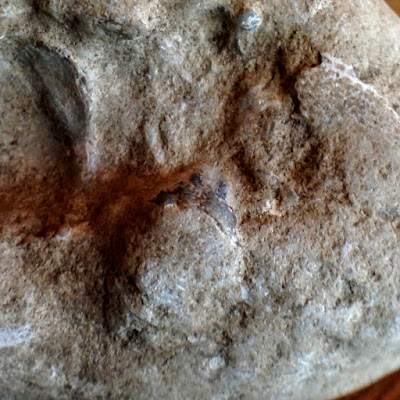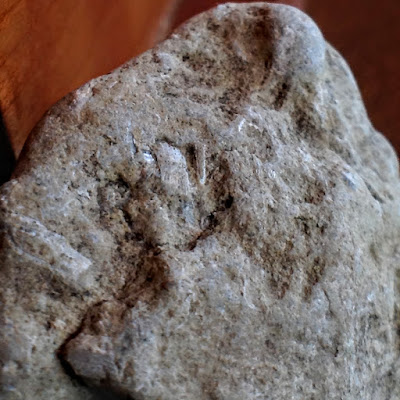This is the last set of photos including some that feature the pop-up head motif that I've mentioned in a previous post. This motif features a head with googly eyes that peek up over another object. It reminds me a bit of a cartoon frog. In this instance, the head is blue-green. In the three examples that I've seen, two of the heads have been this colour; the other one was a dark brown, but in each instance, the head is a slightly different colour than the rest of the stone. In other words, it stands out and catches the eye. The fact that certain techniques or motifs appear repeatedly in these stones suggests to me that they have been worked on by a human hand.
It was interesting to read the archaeologist's statement that the activities at the Arkfeld site in Virginia are "a hoax." My understanding of that word is that there is an intention to deceive or defraud. That seems unduly harsh. I would have had more respect for (if not agreed with) his pronouncement had he simply stated that in his professional judgment, the Arkfeld people were mistaken.
In my own case, I know that there is no intention to perpetuate a hoax or even to convince anyone that what I am finding is rock art. I have no doubt that it is, but for me the goal is simply to study and document as many pieces as possible and to preserve that documentation--and the stones--beyond my lifetime. I am keenly aware that it took me almost fifty years to notice them in the field and that previous generations did not. It is my hope that archaeologists will eventually catch up with those studying portable rock art so I am doing this work with one eye on the past and one towards the future.
On behalf of these ancient artists, I do take exception to the archaeologist's suggestion that they were the "worst artists in prehistory." He does them a great disservice by implying that the art created should meet some preconceived modern notion of what an image should look like. He also states that one should not have to "hold your head this way or get the light from a 67 degree angle" to see the images. Sadly, this pronouncement demonstrates his lack of familiarity with these works.
I have worked extensively with the stones on our farm and have spent countless hours studying them under a macro lens. This makes me an expert in a very small field: our own. I suspect this is true in the Arkfeld case too. My experience in our particular field has taught me that there can be a multitude of images in a single stone. In fact, the artist would have had to turn the stone to many different angles in order to carve them; hence, the need for us to turn the stones to see the images. To me, this is evidence of how clever these ancient artists were. I am constantly in awe of the work they've created and their attention to this kind of detail. They didn't waste an inch of space.
I would argue that it is attention that leads to new discoveries and knowledge and that so-called amateurs can have a role to play in this. A recent CBC article features the headline, "Amazing fossils found by ordinary people thrill scientists" and explains that some of the big fossil discoveries in recent years were made by ordinary people. Kudos to the paleontologists for acknowledging this.
I think the following quote by Richard Farson says it best: "The best ideas aren't hidden in shadowy recesses. They're right in front of us, hidden in plain sight. Innovation seldom depends on discovering obscure or subtle elements but in seeing the obvious with fresh eyes. This is easier said than done because nothing is as hard to see as what's right before our eyes. We overlook what we take for granted. Billions of tea drinkers observed the force of steam escaping from water boiling in a kettle before James Watt realized that this vapor could be converted into energy."
I would suggest that this is precisely what people working with portable rock art are bringing to the field of archaeology: fresh eyes. In my opinion, this is a good thing.

















































































